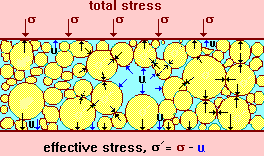The principle of effective stress was enunciated by Karl Terzaghi in the year 1936. This principle is valid only for saturated soils, and consists of two parts:
1. At any point in a soil mass, the effective stress (represented by  or s' ) is related to total stress (s) and pore water pressure (u) as
or s' ) is related to total stress (s) and pore water pressure (u) as
 = s - u
= s - u
Both the total stress and pore water pressure can be measured at any point.
2. All measurable effects of a change of stress, such as compression and a change of shearing resistance, are exclusively due to changes in effective stress.
Compression = ![]()
Shear Strength = ![]()

In a saturated soil system, as the voids are completely filled with water, the pore water pressure acts equally in all directions.
The effective stress is not the exact contact stress between particles but the distribution of load carried by the soil particles over the area considered. It cannot be measured and can only be computed.
If the total stress is increased due to additional load applied to the soil, the pore water pressure initially increases to counteract the additional stress. This increase in pressure within the pores might cause water to drain out of the soil mass, and the load is transferred to the solid grains. This will lead to the increase of effective stress.